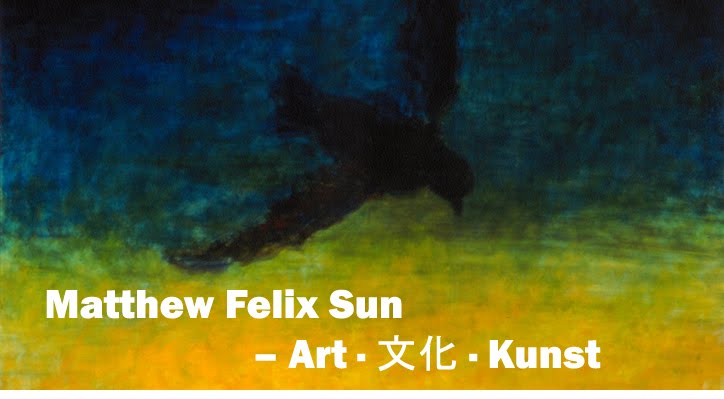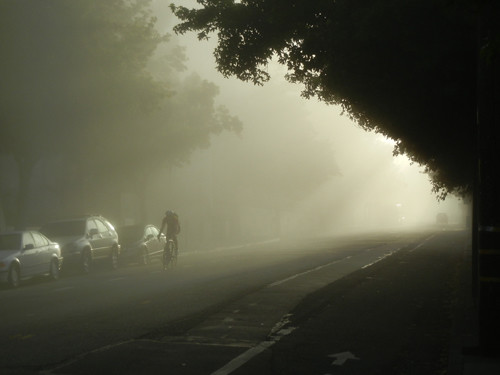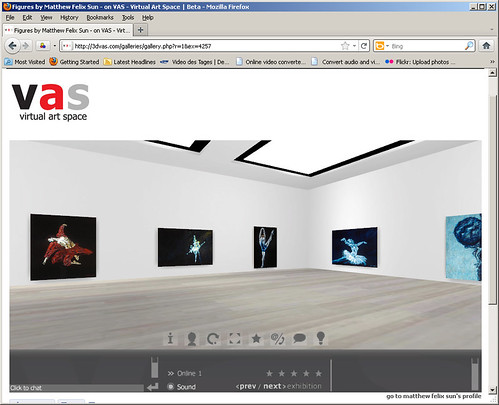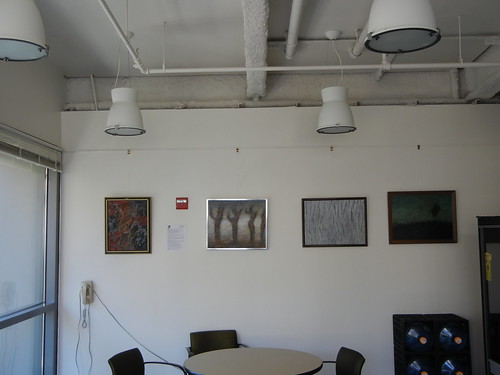Jin is a classicist and has been very influential in the art scene in China. His most famous paintings include a 1983 portrait of a Tajik Bride, whose serene grace was a fresh breath in then China, who was still largely under the influence of socialist realism, such as his own 1966 portrait of Mao:

《塔吉克新娘》, "Tajik Bride", 1983, 60×50cm

《毛主席全身像》, "Full Length Portrait of Chairman Mao", 1966, 262×137cm
After having done many portraits like his "Tajik Bride", and many nudes, he apparently has been searching for new directions again and this new solo exhibit was to showcase his new insight. The focal points and the eye of the storm of this exhibition were three pieces of his copies/updates of realistic paintings by the 17th-century Dutch master Johannes Vermeer - "View of Delft", "The Girl with a Turban", aka "The Girl with a Pearl Earring", and "The Little Street". Based on these three well-known and beloved paintings, Jin made fairly faithful copies, then added some of his own twists. Based on "View of Delft", his "New View of Delft" actually depicted what he sees in Delft today, however, he kept some figures in the original setting and costume - this is an interesting experiment and a deft way to make social study and commentary, but his paining was nowhere near the accomplishment of the Dutch master's.

《新戴尔夫特风景》, "New View of Delft", Jin Shangyi

View of Delft, Johannes Vermeer
United States public domain tag
His updates of the "Girl with a Turban", or "Girl with a Pearl Earring", named "Frightened Girl with a Pearl Earring", was not a successful attempt. The girl looked the same albeit with far less vitality. The lively surfaces of the original became deaden plastic ones. Most damaging was a delicate right hand Jin added to the sitter, which looked utterly out of place. This copy is a pure academic exercise and to exhibit it as some great progress is rather egomaniac.

《惊恐的戴珍珠耳环的少女》 "Frightened Girl with a Pearl Earring", Jin Shangyi

Girl with a Turban (Girl with a Pearl Earring), Johannes Vermeer
The last of this trio, his update of Vermeer's "The Little Street", a serene genre painting, was remade by Jin into "Old Street of Delft", with the similar composition, but with additions of a modern poster on the wall, and a motorcyclist and his bike. This update was much more intrusive and nonsensical. This is a re-run of 1970s pop art movement and the idea was quite stale. The meaning of this work is rather hard to find. A private joke imposed on the broad audience.

《戴尔夫特老街》, "Old Street of Delft", Jin Shangyi

The Little Street, Johannes Vermeer
The praise he garnered were mostly from establishments. 潘公凯, PAN Gongkai, president of the Central Academy of Fine Arts claimed that these three pieces "让我们看到了这种对古典精神的深刻领会,看到了高难度的技巧,看到了拼贴之后仍然浑然一体的自身圆满性。 作为以古典写实技巧与拼贴组合为特征的新的油画风格取向——'后古典'——将日益显现出它的潜在生命力。" ("let us see the deep understanding of the spirit of classic, see most accomplished skills, even see a seamless whole with these collages. As a combination of classical realist techniques and a new style of approach based on collage - 'post-classicism' - it will increasingly reveals its potential vitality.")
However, some critics were not persuaded by this "new" approach. 孔祥祥, KONG Xiangxiang, editor of "China Collect" said that
如果靳尚谊先生是一个普通的画家,他这么做是他自己的事。但作为中国美术界的领军人物,其艺术观念和实践令人失望。我们多么希望他引领中国美术登上另一 座高峰,但他却自得其乐地秀着本该是美院学生做的功课。与原作比较,临仿作品显得矫揉而浮华。单从这次展览的三幅画而言,这位一生忠实于写实主义的老先 生,正离古典写实的真谛渐行渐远,而在当代艺术的道路上,他还迷失在岔路口。aming, Internet art critic is even more critical:
If Mr. Jin Shangyi were an ordinary painter, what he does is his own business. But as the leader of China's arts community, his artistic concept and practices disappoint. We expect him to lead Chinese art onto another plateau, yet he is content to show off pieces should be the homework of Art Academy students. Compared to the originals, his copies were mannered and flamboyant. Based on these three paintings included in this exhibition, this old gentleman, life-long adherent to realism, is drifting farther away from classical realism, yet, in the contemporary art field, he has lost in the fork in the path.
靳尚谊说 观念不重要,技法才重要?应该引起警惕,不能被误导入歧途。没有观念的画是没有灵魂的画,从美术史的角度来看,美术的发展史同样也是美术观念的发展史。这 在中国画中也不例外。只有观念变化才能带来艺术的创新变化,靳尚谊这样对待观念是把油画带进死胡同,丧失了创造力,就脱离了艺术的本质,油画也就死了! (乐梦融)
Jin Shangyi said the concept is not important, only technique is important? This should arouse alarm, so people won't be misled into the wrong road. There is no soul without concept. From the perspective of art history, art history is also the history of art concept development. Chinese painting is no exception. Only change of concept can bring innovation in the arts creation. Jin Shangyi's view on concept is to lead the oil painting into a dead end, to the loss of creativity, to the drifting away from the nature of art, and oil painting will die! (LE Mengrong)
Related posts on Art · 文化 · Kunst:
- Last Call - "The Girl With A Pearl Earring" in De Young Museum, San Francisco
- My Favorite Paintings in Mauritshuis, Den Haag, Netherlands
- Paintings As Pivotal Elements
- Last Chance to See Terracotta Warriors in San Francisco Asian Art Museum
- Birth of Impressionism at De Young Museum, San Francisco
- Venetian Masterpieces from Vienna at De Young Museum
- My Favorite Works at De Young Museum, San Francisco
- My Favorite De Young Museum Collections







































